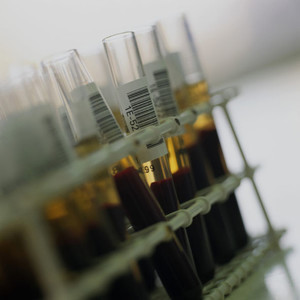Rituximab is a chimeric, monoclonal antibody directed against CD20 expressed on B lymphocytes [1]. Currently approved indications for use are non-Hodgkin lymphomas, chronic lymphatic leukaemia, rheumatoid arthritis, granulomatosis with polyangiitis and microscopic angiitis [2]. However, rituximab is frequently used ‘off label’ for the treatment of numerous antibody-dependent autoimmune diseases [3].
Many biosimilars for rituximab are in development [4] and numerous studies have been performed investigating biosimilarity between proposed biosimilar products [5]. These studies tend to have a similar design: in large and expensive trials, pharmacokinetics (PK) and pharmacodynamics (PD) of proposed biosimilar rituximab are compared in patients [5].
In their study, researchers from Austria and Canada used a different approach [6]. The US Food and Drug Administration (FDA) and the European Medicines Agency (EMA) suggested in their published guidance on the development of biosimilars to compare PD in the steep part of the dose-response curve, which is close to the half-maximal effective concentration (EC50) [7, 8]. For rituximab, the in vitro EC50 is ≤1 µg/mL [9]. However, no data on the half-maximal effective dose (ED50) was available. Interestingly, no dose-finding studies have been performed for the use of rituximab in non-malignant diseases.
Therefore, Schoergenhofer et al. investigated the ED50 of rituximab in healthy volunteers. As infusion of 1 mg/m2 rituximab already depleted 97% [95% confidence interval (CI) 94−100%, n = 8] of circulating CD20+ cells; doses were decreased to 0.3 and 0.1 mg/m2, which depleted 74% (55−82%, n = 4) and 68% (57−95%, n = 4), respectively. Hence, the ED50 of rituximab is <0.1 mg/m2 (<1/3750 of a standard dose) and a ceiling effect is seen at higher doses. Comparison of PD effects at clinically used doses is therefore considered insensitive and essentially useless. This may also have led EMA to accept non-inferiority, rather than standard equivalence designs, for biosimilarity trials with rituximab [10]. Furthermore, based on PK modelling the authors concluded that rituximab dosing in non-malignant diseases should be reconsidered and based on solid PK/PD data.
In a consecutive, randomized, double-blind pilot trial they compared the effects of a proposed biosimilar rituximab product with the originator substance with single infusions of 0.1 (n = 24) and 0.3 mg/m2 (n = 12) in healthy volunteers. There was no difference in depletion of CD19/CD20+ counts, suggesting similar PD potency.
One of the limitations the authors encountered was the inability to compare PK for these low doses, due to target-dependent drug elimination, and the lower limit of quantification of the assay was inadequate to reliably measure drug levels at doses <1 mg/m2.
The authors concluded that this trial demonstrates an alternative, cost-effective, more sensitive approach to comparing PD of biosimilar rituximab using pharmacological principals.
Conflict of interest
Several of the authors of the research paper [1] reported conflict of interest, including being employed by Apotex Canada. For full details of the authors’ conflict of interest, see the research paper [6].
Abstracted by Dr Christian Schörgenhofer, Department of Clinical Pharmacology, Medical University of Vienna, Austria.
Editor’s comment
Readers interested to learn more about biosimilarity are invited to visit www.gabi-journal.net to view the following manuscripts published in GaBI Journal:
Data requirements to demonstrate biosimilarity in the EU
Demonstrating interchangeability and biosimilarity for US biosimilars
GaBI Journal is indexed in Embase, Scopus, Emerging Sources Citation Index and more.
Readers interested in contributing a research or perspective paper to GaBI Journal – an independent, peer reviewed academic journal – please send us your submission here.
Related articles
Biosimilarity does not mean extrapolation of all indications
Demonstrating biosimilarity in the EU
References
1. Maloney DG, Liles TM, Czerwinshi DK, et al. Phase I clinical trial using escalating single-dose infusion of chimeric anti-CD20 monoclonal antibody (IDEC-C2B8) in patients with recurrent B-cell lymphoma. Blood. 1994;84:2457-66.
2. European Medicines Agency. Summary of Product Characteristics (SmPC) MabThera. 2014 [homepage on the Internet]. [cited 2018 Jul 6]. Available from: www.ema.europa.eu/docs/en_GB/document_library/EPAR_-_Product_Information/human/000165/WC500025821.pdf
3. Berntsson SG, Kristoffersson A, Bostrom I, Feresiadou A, Burman J, Landtblom AM. Rapidly increasing off-label use of rituximab in multiple sclerosis in Sweden - Outlier or predecessor? Acta Neurol Scand. 2018 May 24. doi:10.1111/ane.12963. [Epub ahead of print]
4. GaBI Online - Generics and Biosimilars Initiative. Biosimilars of rituximab [www.gabionline.net]. Mol, Belgium: Pro Pharma Communications International; [cited 2018 Jul 6]. Available from: www.gabionline.net/Biosimilars/General/Biosimilars-of-rituximab
5. Greenwald M, Tesser J, Sewell KL. Biosimilars have arrived: Rituximab. Arthritis. 2018;3762864. doi:10.1155/2018/3762864
6. Schoergenhofer C, Schwameis M, Fribas C, et al. Single, very low rituximab doses in healthy volunteers - a pilot and a randomized trial: implications for dosing and biosimilarity testing. Sci Rep. 2018;8(1):124. doi:10.1038/s41598-017-17934-6
7. European Medicines Agency. Guideline on similar biological medicinal products containing biotechnology-derived proteins as active substance: non-clinical and clinical issues. EMEA/CHMP/BMWP/42832/2005 Rev1 [homepage on the Internet]. [cited 2018 Jul 6]. Available from: www.ema.europa.eu/docs/en_GB/document_library/Scientific_guideline/2015/01/WC500180219.pdf
8. U.S. Food and Drug Administration. Scientific considerations in demonstrating biosimilarity to a reference product guidance for industry. 2015 [[homepage on the Internet]. [cited 2018 Jul 6]. Available from: www.fda.gov/downloads/drugs/guidances/ucm291128.pdf
9. Vugmeyster Y, Howell K, Bakshl A, et al. Effect of anti-CD20 monoclonal antibody, Rituxan, on cynomolgus monkey and human B cells in a whole blood matrix. Cytometry A. 2003;52(2):101-9.
10. Mielke J, Jilma B, Jones B, et al. An update on the clinical evidence that supports biosimilar approvals in Europe. Br J Clin Pharmacol. 2018;84(7):1415-31.
Permission granted to reproduce for personal and non-commercial use only. All other reproduction, copy or reprinting of all or part of any ‘Content’ found on this website is strictly prohibited without the prior consent of the publisher. Contact the publisher to obtain permission before redistributing.
Copyright – Unless otherwise stated all contents of this website are © 2018 Pro Pharma Communications International. All Rights Reserved.








 0
0











Post your comment